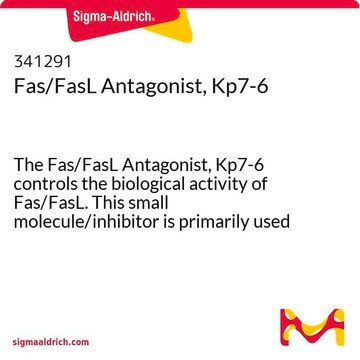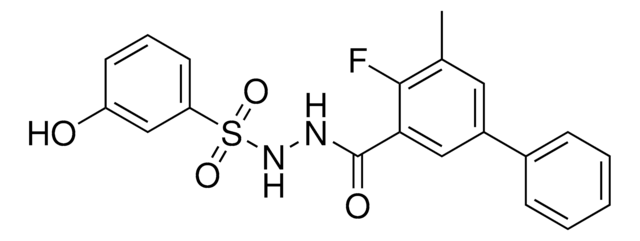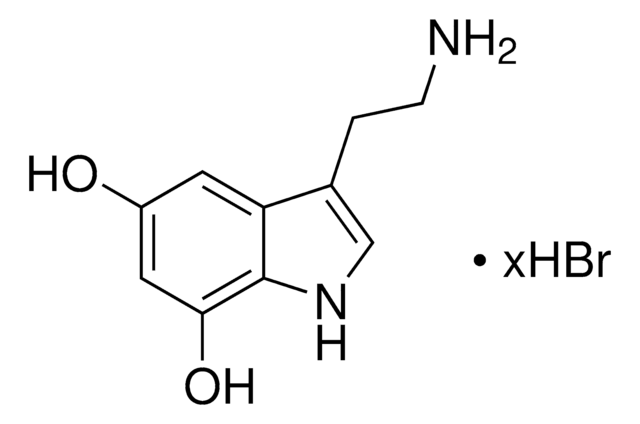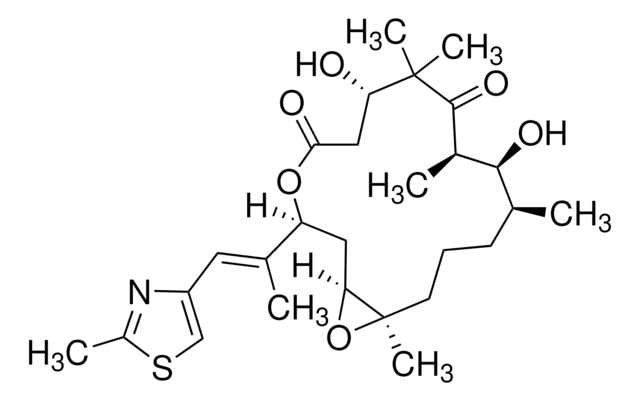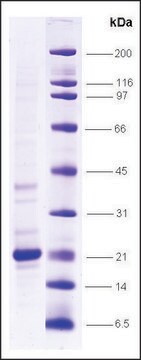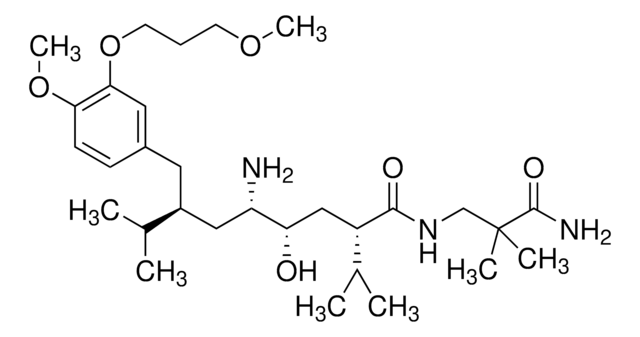SRP3036
Fas Ligand human
recombinant, expressed in CHO cells, ≥95% (SDS-PAGE), ≥95% (HPLC), suitable for cell culture
Synonim(y):
APTL, Apo I Ligand, CD95L, TNFSF6, soluble Fas Ligand (sFasL)
Zaloguj sięWyświetlanie cen organizacyjnych i kontraktowych
About This Item
Kod UNSPSC:
12352200
NACRES:
NA.32
Polecane produkty
pochodzenie biologiczne
human
rekombinowane
expressed in CHO cells
Próba
≥95% (HPLC)
≥95% (SDS-PAGE)
Formularz
lyophilized
siła działania
≤10.0 ng/mL
masa cząsteczkowa
17.9 kDa
opakowanie
pkg of 10 μg
metody
cell culture | mammalian: suitable
zanieczyszczenia
<0.1 EU/μg endotoxin, tested
kolor
white to off-white
przydatność
suitable for molecular biology
numer dostępu UniProt
Warunki transportu
wet ice
temp. przechowywania
−20°C
informacje o genach
human ... FASLG(356)
Opis ogólny
Fas Ligand (FasL) is a member of the TNF (tumor necrosis factor) superfamily that is expressed on the cell surface of activated T cells. It can be present as soluble form in the circulation or membrane bound form in cells. Recombinant human soluble Fas Ligand is a 17.9kDa protein comprising the TNF homologous region of FasL and contains an 8 residue N-terminal His-Tag. Both human and murine sFasL are fully active on human and murine cells.
Zastosowanie
Fas ligand human has been used to induce apoptosis in T-cell lymphoma-derived HuT78 cells and jurkat cells.
Działania biochem./fizjol.
Binding of Fas Ligand (FasL) to Fas receptor triggers apoptosis in Fas-bearing cells. FasL has the ability to kill T cells and activated B cells which leads to down-regulation of the immune response. The mechanism of Fas induced apoptosis involves recruitment of pro-caspase 8 through an adaptor molecule called FADD (Fas-Associated protein with death domain) followed by processing of the pro-enzyme to active forms. These active caspases then cleave various cellular substrates leading to the eventual cell death. FasL is also involved in AGE (advanced glycation end-product)-mediated apoptosis in human retinal ARPE-19 cells, suggesting its role in diabetic retinopathy. Changes in the activity of FasL suppresses normal apoptosis, leading to abnormal survival and growth of tumor cells. Mutations in the FasL gene causes autoimmune lymphoproliferative syndrome.
Sekwencja
HHHHHHHHPS PPPEKKELRK VAHLTGKSNS RSMPLEWEDT YGIVLLSGVK YKKGGLVINE TGLYFVYSKV YFRGQSCNNL PLSHKVYMRN SKYPQDLVMM EGKMMSYCTT GQMWARSSYL GAVFNLTSAD HLYVNVSELS LVNFEESQTF FGLYKL
Postać fizyczna
Lyophilized with no additives.
Rekonstytucja
Centrifuge the vial prior to opening. Reconstitute in water to a concentration of 0.1-1.0 mg/ml. Do not vortex. This solution can be stored at 2-8°C for up to 1 week. For extended storage, it is recommended to further dilute in a buffer containing a carrier protein (example 0.1% BSA) and store in working aliquots at -20°C to -80°C.
Ta strona może zawierać tekst przetłumaczony maszynowo.
Kod klasy składowania
11 - Combustible Solids
Klasa zagrożenia wodnego (WGK)
WGK 3
Temperatura zapłonu (°F)
Not applicable
Temperatura zapłonu (°C)
Not applicable
Wybierz jedną z najnowszych wersji:
Masz już ten produkt?
Dokumenty związane z niedawno zakupionymi produktami zostały zamieszczone w Bibliotece dokumentów.
Fas ligand mediates activation-induced cell death in human T lymphocytes.
Alderson MR, et al.
The Journal of Experimental Medicine, 71-77 (1995)
The molecular architecture of the TNF superfamily.
Bodmer JL, et al.
Trends in Biochemical Sciences, 27, 19-26 (2002)
The metalloproteinase matrilysin proteolytically generates active soluble Fas ligand and potentiates epithelial cell apoptosis.
Powell WC, et al.
Current Biology, 9, 1441-1447 (1999)
Karthik M Kodigepalli et al.
Cell cycle (Georgetown, Tex.), 16(2), 179-188 (2016-12-09)
Sterile α motif and HD domain-containing protein 1 (SAMHD1) is a mammalian dNTP hydrolase (dNTPase) that regulates intracellular dNTP balance. We have previously reported that SAMHD1 mRNA and protein levels are significantly downregulated in CD4
D H Lynch et al.
Immunity, 1(2), 131-136 (1994-05-01)
The gene for the mouse Fas ligand was cloned and its chromosomal position determined. Fasl was tightly linked to gld (no crossovers in 567 meiotic events) on mouse chromosome 1 and closely linked with a novel member of the same
Nasz zespół naukowców ma doświadczenie we wszystkich obszarach badań, w tym w naukach przyrodniczych, materiałoznawstwie, syntezie chemicznej, chromatografii, analityce i wielu innych dziedzinach.
Skontaktuj się z zespołem ds. pomocy technicznej